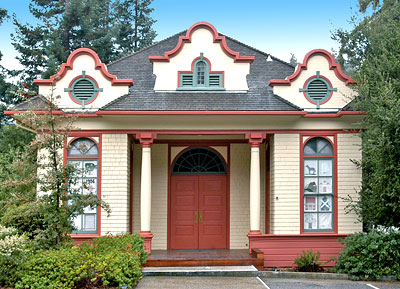National Register of Historic Places in San Mateo County
Portola Valley School
775 Portola Road
Portola Valley
Built 1909
The Portola Valley School, designed by Palo Alto architect LeBaron R. Olive, is one of the few remaining early 20th century school buildings in the Mission Revival style. Olive's design was a conspicuous effort to execute the style on a small scale in wood.
Architectural historians consider that the Mission Revival style was developed in part from the shingle tradition. Therefore, the extensive usage of wooden shingles in this interpretation is significant and especially appropriate here in virgin redwood country.
Adapted from the NRHP nomination.

After a half century's existence, the Searsville School District's attendance reached a peak in 1909. The census listed 76 children eligible to attend, even though only 53 enrolled. The same year the name was changed to the Portola School District. On June 14, 1909, a bond election was passed to provide a second school building.
Portola taxpayers were affluent San Franciscans, who owned the large estates in the valley. They may have encouraged use of Mission Revival to complement their summer showplace homes designed by the style's protagonists: A. Page Brown, Willis Polk, and Julia Morgan.
Mission Revival was most popular on the San Francisco Peninsula. The Stanford University Romanesque buildings had been a forerunner of the style. The Burlingame railroad depot is a fully realized example of the Mission Revival style in San Mateo County.
Adapted from the NRHP nomination.
